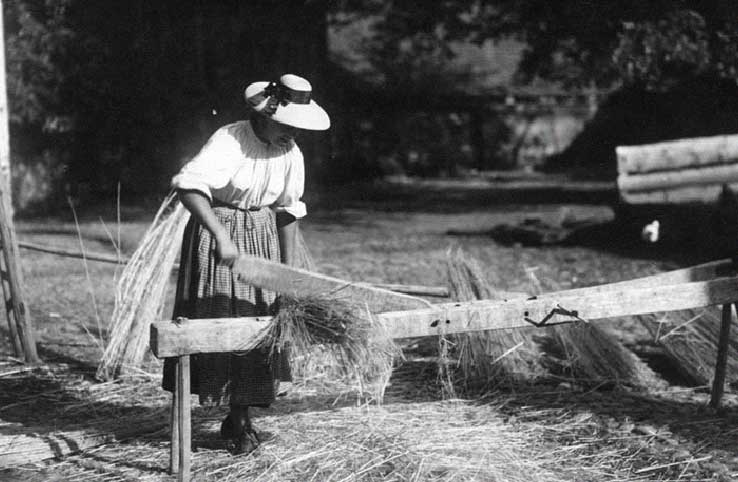then in shade excorticate it, and separate the fibres
Original French: puys a l’umbre le excorticquer, & ſeparer les fibres
Modern French: puys à l’umbre le excorticquer, & separer les fibres
Notes
Scutching hemp

Woman scutching hemp with the melita, Sibu County ca. 1940.
Scutching
Scutching is a step in the processing of cotton or the dressing of flax or hemp in preparation for spinning. The scutching process separates the impurities from the raw material, such as the seeds from raw cotton or the straw and woody stem from flax fibers. Scutching can be done by hand or by a machine known as a scutcher. Hand scutching of flax is done with a wooden scutching knife and a small iron scraper. The end products of scutching flax are the long flax fibers, short coarser fibers called tow, and waste woody matter called shive.
To scutch flax by hand, the scutching knife is scraped down with a sharp strike against the fibers while they hang vertically. The edge of the knife is scraped along the fibers to pull away pieces of the stalk. This is repeated until all of the stalk has been removed and the flax is smooth and silky. When scutching was done by hand, people could scutch up to 15 pounds (6.8 kg) of flax in one day, depending on the quality of the flax, as coarser flax, harder flax, and poorly retted flax takes longer to scutch. Retting removes the pectins that bind the fibers to the stalk and each other, so under-retted flax is harder to separate from the stalk, and often gets damaged in the scutching process. Over-retting the flax causes the fibers to deteriorate and break. These broken fibres are called codilla, which can be used along with heckled tow to make yarn.
In the scutching process, some of the fiber is also scutched away along with the stalk, a normal part of the process.
Teillage
Le teillage (action de teiller) est une opération mécanique qui permet de séparer les fibres textiles du bois et de l’écorce par broyage et battage. Il s’applique également aux fibres de chanvre et de lin.
Teillage du chanvre
Le teillage est une étape du travail du lin et du chanvre effectuée après le broyage des tiges. Les fibres textiles sont séparées du bois pour obtenir de la filasse de 70 à 80 cm de longueur. À l’époque ce travail était fait à la main durant les veillées. Il faut prendre le brin de lin/chanvre à son extrémité la plus grosse et dégager la rognure de sa filasse de manière à «déchausser» la tige. Puis tirer sur le bout de ruban obtenu et arracher toute la filasse du brin. Le geste est répété jusqu’à accumuler une poignée de filasse qui est nouée pour donner une queue de chanvre. Ce travail est aujourd’hui mécanisé2
L’ouvrier qui teillait portait au xvie siècle le nom de «tellie » dans le nord de la France. On le nomme aujourd’hui «teilleur» ou «tilleur».